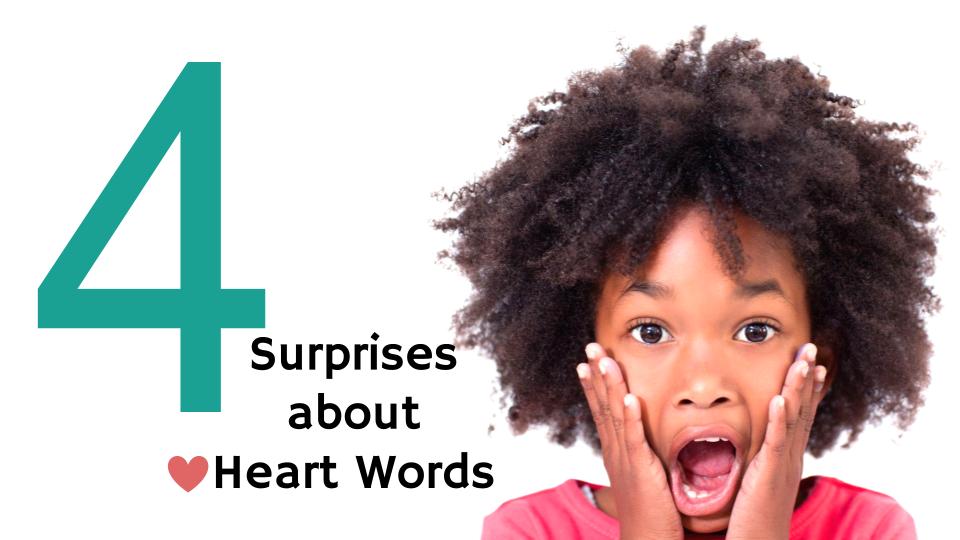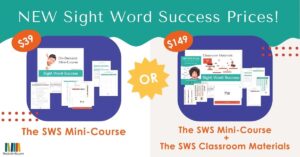As more and more schools are making shifts to more brain-friendly practices, many have embraced the idea of marking certain parts of a high-frequency word with a heart, a star, or a surprise face. Chances are you have, too! And whatever the symbol you use, your intention is the same – to help children learn HFW more easily by drawing their attention to irregular sound-spellings within the word.
This is good news! However – as often happens when something becomes a trend – important ideas can easily get lost in translation.
Today, we share four things we’ve noticed as educators lean into the use of “heart words” to scaffold high-frequency word learning. You might find these surprising!
Surprise #1: Not all high-frequency words are heart words. Heart words, by definition, are only words that include sound-spellings that are irregular or uncommon. We like to refer to these less common sound-spellings as “surprises.”
Surprise #2: The brain doesn’t memorize the spellings of words visually. The heart (or whatever you use) above a part of a word is a reminder that the particular sound-spelling is less predictable, not that the word needs to be learned by “heart.” The tricky sound-spelling is a bit of a surprise! But that part still has to be learned as part of the larger meaningful string of letters that aligns to the individual sounds in the word, not by “heart.” Alphabetic principle applies, even when there are irregular spellings involved.
Surprise #3: Drawing a heart (or whatever) above the tricky sound-spellings is not the most important part of this approach to teaching words. Actually, the most important part of this approach to teaching irregularly spelled high-frequency words is showing children how to pull apart words, listen in to their individual sounds, and then align those sounds to each corresponding spelling, whether that spelling is surprising or not.
Surprise #4: You don’t have to use a heart symbol to teach the heart of heart words! You can actually use any mnemonic and draw anything over the tricky spelling. You could draw a frog and say that the less regularly spelled parts of the word “jump out at you.” You could draw a thought bubble and say that these are the parts of the word that “we really need to think about.” We choose to draw a surprise emoji and tell children that the less regular spellings are “surprises in the word.” Basically, what you draw is not the important part.
In summary, understanding the why behind the heart word approach to high-frequency words is critical to effective instruction. The actual hearts themselves are less important.
These four surprises are just a starting place to really understand how to make words stick once and for all by scaffolding orthographic mapping. There’s lots more to learn and understand.
Of course, if you don’t have a firm grasp of why (the brain science) an instructional practice works for the brain, then the how (the classroom implementation) is at risk of evolving in ways that are less science-aligned and therefore less effective than you’d intended.
But when you do understand orthographic mapping (the secret sauce of word learning) and how to leverage it in brain-friendly ways for learning any words (not just irregularly spelled words!), a whole new world of possibilities opens up for your children.
So, whether you’re already a “heart” word fan, or you have never heard of marking high-frequency words with hearts or stars or whatever, we invite you to check out our Sight Word Success Mini-Course, where you’ll come to really understand the power and importance of orthographic mapping when it comes to learning to read and write words fluently.
And if you want to know more about why heart words are important and how orthographic mapping is the whole point of drawing attention to certain word parts in the first place, then our Sight Word Success Mini-Course can support you with that, too! We will show you how to teach children to use this powerful tool–orthographic mapping–in ways that will help them learn high-frequency words more easily,
Word learning doesn’t come from drawing hearts, frogs thought bubbles, or surprise faces over word parts. It comes from understanding how the brain actually learns words and how to scaffold orthographic mapping through powerful word-learning routines. And if you want to get up and running with TOMORROW, then our Sight Word Success Classroom Materials can help you with that! These materials include full lessons for the 109 Power Words, which make up 50% of what beginning readers will encounter in their texts. Best of all, when you buy the classroom materials, you get the mini-course for free!
And as our way of celebrating teachers this month, we’ve cut the prices in half for the Sight Word Success Mini-Course (from $79 to $39) and the Sight Word Success Classroom Materials (from $299 to $149).
We want to make teaching easier for you and learning words easier for your students! And we hope that’s not a surprise!





Will the Sight Word Success be part of the Shifting the Balance course?
Amy, there in the online course Module 4 is decicated to high-frequency word instruction and orthographic mapping. Sight Word Success goes a bit deeper and includes additional resources, but you will get a strong foundation in the online course.